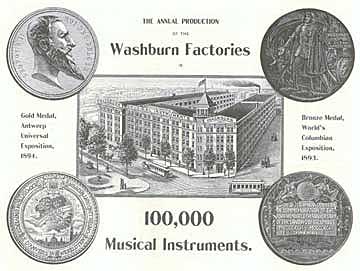So, how about the numbers?
Just look what those fellows were up to a hundred years ago:

Click for a closer look at this vintage Washburn instrument catalog page.
All this buildup just to try out my new scanner?
Yep.
Back to Index Page
It's all a matter of "scale"
Handmade?
© Frank Ford, 2/8/99
Long about the turn of the Century (the last one, you know, 1900)
the C. F. Martin company was making more than 300 instruments a year, including guitars
and mandolins. Virtually all these instruments had Brazilian rosewood backs and sides.
Today, Martin makes around 60,000 instruments a year, virtually none of which are
made of Brazilian rosewood. As we all know, Brazilian rosewood is quickly achieving
the rarity status of unobtanium.
In the early years of this century, lots of instruments were made by, or under contract
for, the Lyon and Healy Company. The more professional ones were labeled "Lyon and Healy Own Make" while others received different trademarks, such as "American
Conservatory," "Lakeside" and many others. The most famous subsidiary
trademark was the middle name of one of the founders, George Washburn Lyon.
Today the Washburn trademark is owned and used by a company that has no direct connection with the original, by the way.
It's common for us to discuss "handmade" instruments,
but particularly in the days before computer controlled equipment, instruments of
various grades were all handmade to pretty much the same extent. It was really a
matter of how fast those hands had to work! Cheap instruments were really cranked
out with a minimum of attention to detail, just as today. That's why, for instance
we see neck dovetails loosen over time on the old Washburns and Regals, but never
on Martins or Gibsons. They just made up for poor joinery by filling gaps with more
glue.
So, how about the numbers?
Just look what those fellows were up to a hundred years ago:

Click for a closer look at this vintage Washburn instrument catalog page.
All this buildup just to try out my new scanner?
Yep.
Back to Index Page